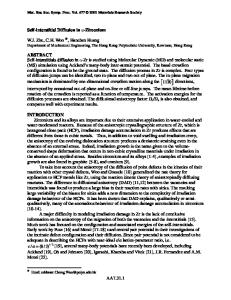Diffusion of Fluorine-Silicon Interstitial Complex in Crystalline Silicon
- PDF / 1,168,233 Bytes
- 6 Pages / 612 x 792 pts (letter) Page_size
- 59 Downloads / 353 Views
E9.1.1
Diffusion of Fluorine-Silicon Interstitial Complex in Crystalline Silicon Scott A. Harrison, Thomas F. Edgar and Gyeong S. Hwang Department of Chemical Engineering, University of Texas at Austin Austin, TX 78712 ABSTRACT Based on first principles density functional theory calculations, we identify the structure and diffusion pathway for a fluorine-silicon interstitial complex (F-Sii). We find the F-Sii complex to be most stable in the singly positive charge state at all Fermi levels. At mid-gap, the complex is found to have a binding energy of 1.08 eV relative to bond-centered F+ and (110)-split Sii. We find the F-Sii complex has an overall migration barrier of 0.76 eV, which suggests that this complex may play an important role in fluorine diffusion. Our results should lead to more accurate models that describe the behavior of fluorine co-implants crystalline silicon. INTRODUCTION As silicon transistor devices are scaled down, the formation of ultrashallow junctions less than 20 nm in depth will be required to prevent short channel effects. The ultrashallow junction fabrication involves low energy dopant implantation followed by a high temperature thermal anneal. During the high temperature anneal, transient enhanced diffusion (TED) of implanted dopants is often observed. This rapid diffusion limits the achievement of shallow junction depths. In addition to dopant TED, dopant deactivation which occurs during dopant implantation and annealing can also have a detrimental impact on device performance. In recent years, coimplantation of fluorine with dopants has become a common strategy to reduce dopant TED and deactivation behaviors. In order to accurately model the effects of the fluorine co-implant, a detailed knowledge of fluorine diffusion in crystalline silicon is required. Current understanding attributes F diffusion in silicon to the diffusion of isolated F from a bond-centered site or a tetrahedral site, depending on the Fermi level energy [1]. Previous attempts at explaining fluorine behavior in crystalline silicon have suggested the presence of diffusing fluorine-silicon interstitial (F-Sii) complexes. Park and Kim [2] hypothesized that the formation of mobile F-Sii complexes suppresses the formation of large silicon clusters. Pi and co-workers [3] attributed the loss of flourine (from both interstitial and vacancy rich regions) to the transient diffusion of F-Sii complexes during thermal annealing. In addition, Robison and Law [4] have suggested a rapidly diffusing F-Sii complex must exist in order to accurately model fluorine redistribution during thermal treatment. Clearly, a more detailed understanding of the structure and diffusion of fluorine-interstitial complexes is warranted. In this work, we identify both the lowest-energy F-Sii configurations, which we find to exist in the +1 charge state, as well as its diffusion pathway. At mid-gap, we find the F-Sii+ complex to have a binding energy of 1.08 eV relative to bond-centered F+ (Fbc+) and (110)-split Sii and to have an overall migration barri
Data Loading...


